
Middlesex Canal Association P.O. Box 333 Billerica, Massachusetts 01821
www.middlesexcanal.org

Middlesex Canal Association P.O. Box 333 Billerica, Massachusetts 01821
www.middlesexcanal.org
| Volume 61 No. 1 | October 2022 |
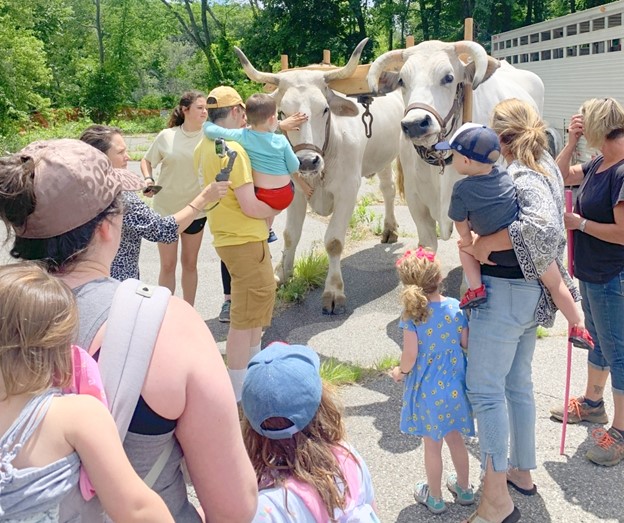
The MCA received a $1500 grant to bring the oxen to Riverfest in June of 2022.
Although there was some initial skepticism, the oxen, Pooch and Bill, were a big hit.
MCA Sponsored Events – 2022 Schedule
Fall Walk: 1:30pm, Sunday, October 16, 2022
Meet at the Middlesex Canal Museum and Visitors’ Center, 71 Faulkner Street, North Billerica, MA 01862
for a three mile walk south along the canal to the smallpox cemetery, a round trip of less than three miles.
Fall Meeting, 1:00pm, Sunday, October 23, 2022
“Cotton Mills of Dover, N.H.”
Speaker: J. Jerimiah Breen
Winter Meeting, 1:00pm, Sunday, February 19, 2023
“Spinning as Industry”
Speaker: Zoë Lawson [https://youtu.be/3Zisvln1QZ8]
Location: Middlesex Canal Museum and Visitors’ Center, 71 Faulkner Street, North Billerica
The Visitors Center/ Museum is open Saturday and Sunday, Noon – 4:00pm, except on a holiday (April 17, 2022, Easter).
The Board of Directors meets the 1st Wednesday of each month, 3:30-5:30pm, except July and August.
Check the MCA website for updated information during the COVID-19 pandemic.
TABLE OF CONTENTS
MCA Sponsored Events and Directions to the MCA Museum and Visitors’ Center
President’s Message: “Dam Removal 2” - by J. Jeremiah Breen
“Construction at 2 Old Elm, our New Museum” - by Betty M. Bigwood
“Middlesex Tavern” - by Debra Fox
Editors’ Letter
Dear Readers,
It has been a long hot, dry summer. Let’s hope the fall season will be filled with beautiful color as the trees prepare for winter. In this issue of Towpath Topics J. Jeremiah Breen has submitted an interesting article concerning the Talbot Mill Dam project, Betty Bigwood has contributed a must-read piece updating the ongoing construction at the new museum site on 2 Old Elm Street, and Debra Fox has completed the issue with an article on the Old Middlesex Tavern.
Enjoy!
Sincerely,
The Editors (Deb, Alec, and Robert)
MCA Sponsored Events
Fall Meeting – 1:00pm, Sunday, October 23, 2022: Cathy Beaudoin, retired librarian of Dover, N.H., has given the Association permission to use her talk on “Cotton Mills of Dover, N.H.” as a basis for a presentation by J. Jeremiah Breen. This will, in all probability, be the last event held by the MCA in the Reardon Room in the Middlesex Canal Museum and Visitor Center at 71 Faulkner Street in North Billerica, MA 01862. The MCA Museum will soon be moving to a new location on 2 Old Elm Street on the opposite bank of the Concord River Mill Pond.
Winter Meeting – 1:00pm, Sunday, February 19, 2023: Zoë Lawson will speak on “Spinning as Industry”. Why was Lowell considered a utopia? View the video recorded at the Charles River Museum, <https://youtu.be/3Zisvln1QZ8>, and come with your questions. Location of the reprise of “Spinning as Industry” yet to be determined.
A technical writer by day, Zoë Lawson is a spinster and public historian by vocation. She has been spinning for more than 35 years and has given numerous demonstrations at historic sites in the Boston area. An active 18th-century re-enactor, Lawson recently began to explore Medieval textile and fiber production. She enjoys experimenting with historical tools and methods and teaching spinning to anyone who wants to learn by doing. (from Charles River Museum Website)
Walks and Bicycle Tours: For more detailed information please access the MCA website at www.middlesexcanal.org about a week prior to the scheduled event.
Directions to Museum: 71 Faulkner Street in North Billerica, MA
By Car
From Rte. 128/95
Take Route 3 (Northwest Expressway) toward Nashua, to Exit 78 (formerly Exit 28) “Treble Cove Road, North Billerica, Carlisle”. At the end of the ramp, turn left onto Treble Cove Road toward North Billerica. At about ¾ mile, bear left at the fork. After another ¼ mile, at the traffic light, cross straight over Route 3A (Boston Road). Go about ¼ mile to a 3-way fork; take the middle road (Talbot Avenue) which will put St. Andrew’s Church on your left. Go ¼ mile to a stop sign and bear right onto Old Elm Street. Go about ¼ mile to the bridge over the Concord River, where Old Elm Street becomes Faulkner Street; the Museum is on your left and you can park across the street on your right, just beyond the bridge. Watch out crossing the street!
From I-495
Take Exit 91 (formerly Exit 37) North Billerica, then south roughly 2 plus miles to the stop sign at Mt. Pleasant Street, turn right, then bear right at the Y, go 700’ and turn left into the parking lot. The Museum is across the street (Faulkner Street). To get to the Visitor Center/Museum enter through the center door of the Faulkner Mill and proceed to the end of the hall.
By Train
The Lowell Commuter line runs between Lowell and Boston’s North Station. From the station side of the tracks at North Billerica, the Museum is a 3-minute walk down Station Street and Faulkner Street on the right side.
President’s Message – “Dam Removal 2”
by J. Breen
At the May 15, 2022 annual meeting of the Association, Eric Hutchins of the National Oceanic and Atmospheric Administration, and Jill Griffiths, P.E., of Gomez and Sullivan, engineers, who was the manager for the 2016 Final Report on the feasibility of restoring diadromous fish to the Concord River, gave an update on plans to restore diadromous fish. The governor of Massachusetts in House Bill 4479, filed February 18, 2022, gave his own succinct update at line 194, “not less than $1,400,000 shall be expended to remove the Talbot Mills Dam in the town of Billerica”.
At the June 22, 2022 meeting of the Middlesex Canal Commission, the commissioners discussed the fact that Bob Martin, manager of CRT Development Realty, LLC, owner of the dam, has said he wants the dam removed as removal ends CRT’s burdensome responsibility for it. The commissioners discussed the possibility of CRT relieving itself of the responsibility by giving the dam to the commission. The 1977 legislative act establishing the commission has the following authorization: “In accordance with its purposes, powers, and duties, the commission may accept gifts from any source, including gifts of real property, or less than fee simple interests in real property”. The question put to the commissioners was “Should the MCC accept the dam?” A roll call vote ensued. The question was answered “Yes” on a vote of 6-1, with 2 town commissioners absent.1
Keeping the dam and using it to aid fish migration might be better for the fish. The 1700 map of Billerica has three falls in the Concord River downstream of the Fordway. Three miles downstream of Billerica Falls/Talbot Dam is the Wamesit Falls/Centennial Dam. The photos 1 and 2 show the bottom of the river at Wamesit Falls during low flow, ~ 55 cfs at Rogers St. gauge. With the Talbot Dam removed and the summit pond drained, migrating fish would have to overcome three falls between Faulkner Street and the Fordway. The success rate of passage would seemingly be much better if the two upper falls were kept drowned by the summit pond and the Talbot Dam had a regulated flow through a restored 1828 fishway and rock ramp. The reviewer of the 2016 Final Report considered whether the dam location might be impassable because the current was too fast. He recommended the cost of dam removal include a contingency should the remnant falls not be passable.2
The fishway was required by state law when the dam was built in 1828. Photo A is the low end with a concrete plug, said to have been poured in the 1960s. Photo B is a bird’s eye view. Restoring the 1828 fishway was not considered as an alternative to removing the dam in the 2016 Final Report. Instead, the massive masonry structure in Photo C was the comparative. Three miles downstream at the Wamesit Falls/Centennial Dam is a real, modern fishway, built in 1990, for possible comparison, Photo D.
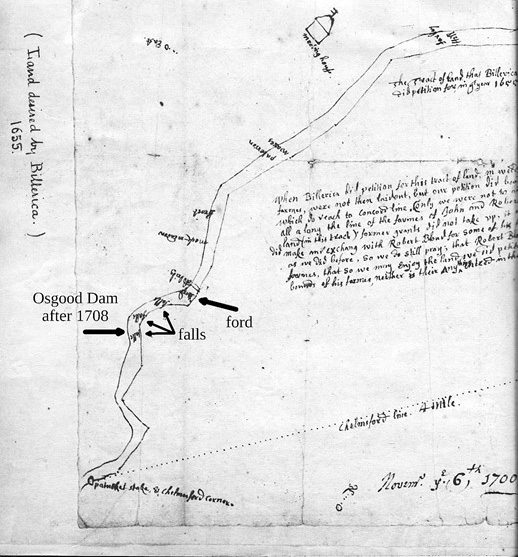
Detail of “Map of Billerica, 1700”
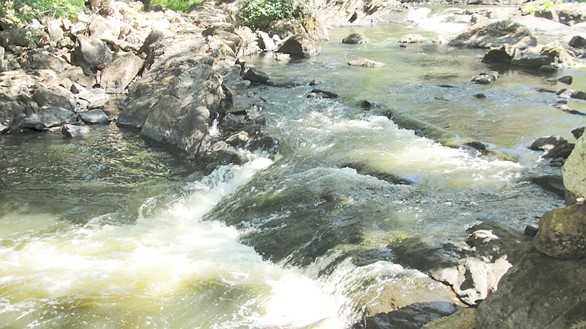
Photo 1
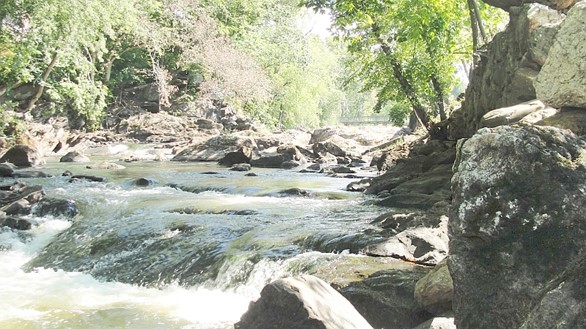
Photo 2
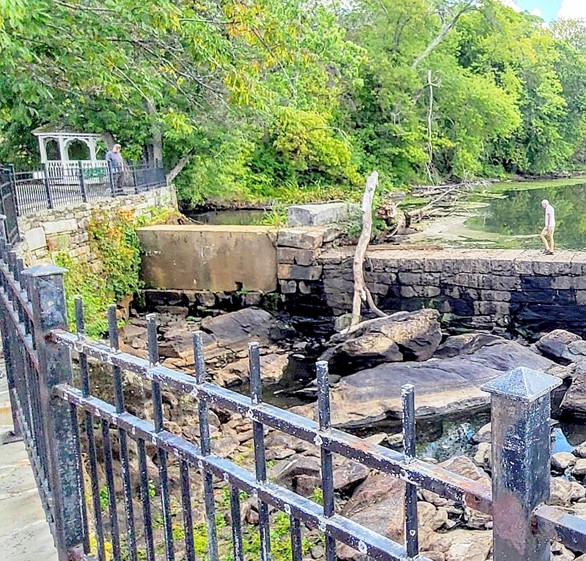
Photo A
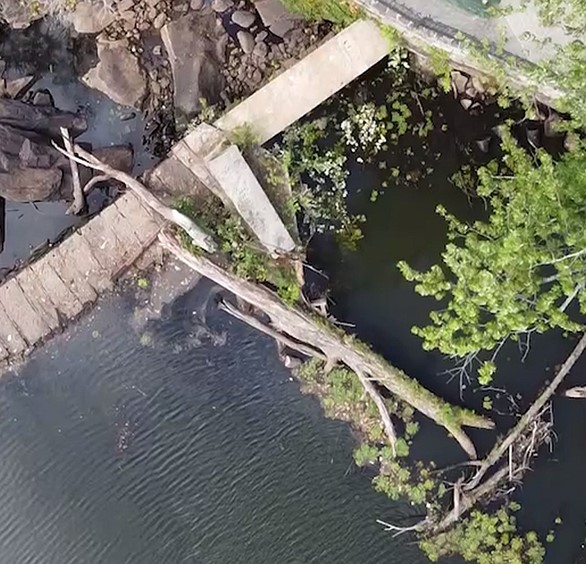
Photo B
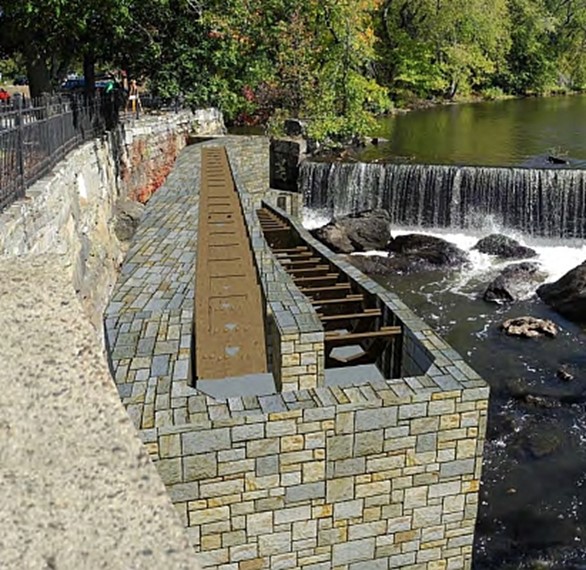
Photo C
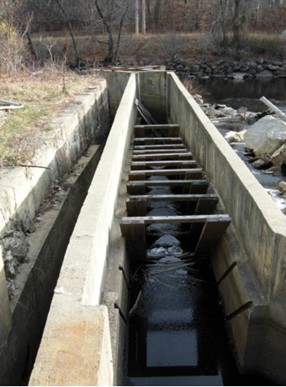
Photo D, Wamesit Falls / Centennial Dam fishway and downstream passage
Notes.
1. Record of June 25, 2022 email from Tom Lincoln, secretary of the commission, to Bob Martin, subject: June 22 vote on the Talbot Dam.
2. Review of Talbot Mills Dam Removal Feasibility Study by Streamworks, PLLC, September 1, 2020 revision, page 16, Recommendation for Further Study 8.
https://app.box.com/s/ebjwsoaxc0tnd2h04o33fj8mh72ajxzq
Public, Reports, Independent Reviews, Review of 2016 Feasibility Study.
A. Dam Removal 1 has footnotes and more information. Towpath Topics, Vol. 58, No. 1 (Sept. 2019), http://middlesexcanal.org/towpath/towpathtopicsSept2019.htm#president
B. Centennial Island Hydroelectric Project, FEASIBILITY STUDY TO ADD A SECOND TURBINE/GENERATOR PACKAGE TO THE EXISTING HYDROELECTRIC FACILITY, by Olson Electric Development Co., Inc., c.2011.
“Map of Billerica, 1700” that part showing three falls downstream of the Fordway before the 1708 Osgood Dam was built.
See “A Short History of the Milldam at North Billerica 1653-1995” by Alec Ingraham, Fig. 1 and 2, The Billerica Historical Society, 1995. The map citation is “Land Desired by Billerica, 1655”, from Ancient Plans and Grants, Etc., Vol. 1, p. 191, Massachusetts Archives: Maps and Plans, No. 207. Internet Archive, https://tinyurl.com/IngrahamHistory.
Construction at 2 Old Elm, our New Museum
by Betty M. Bigwood
When the Building Committee began to anticipate this year- 2022, we planned to store our furnishings in the attic in August, move out of our current museum and dedicate our energy to completing 2 Old Elm. Yet here it is mid-September and no moving date is official. Contractor Bill Cogley finally was able to contact the Billerica Electrical Inspector who firmly said that we could not hook up to the National Grid until we were weather tight: defined as all windows and doors installed and the cement floor laid. Fortunately, they have been ordered and should arrive in mid-late October. In the meanwhile, Contractor Cogley can prepare the window frames ahead of time so installation should go swiftly – all 11 windows and 4 doors. Bill Cogley plans to use 12-inch-wide framing boards to bridge the gap between the inner and outer walls of our 2 ft wide walls.
The windows are from the Marvin Elevate series made in Minnesota and while double-glazed the muntins are actually stuck to the glass recommended by our architect, Christina McMahon/Caveney Architectural Collaborative to look authentic in our 1870’s woolen store house.
The doors have proven to be a challenge. We initially chose five-foot-wide double doors to allow wheelchair access. (Joan Jones had frequently asked that we have wide openings because getting Nolan into buildings was a challenge in his wheelchair) This was changed to six-foot-wide doors when we found that the Commonwealth required very expensive ($18,000 each) automatic door openers for the smaller doors. This required that we engage Pro Cut ($2855) to enlarge the twenty-inch-thick brick openings –both sides- of two exit doors with a diamond bladed saw. This is a dusty, messy job. We wanted wood doors but the cost, months of delay in getting them, high upkeep in painting them and our architects recommendation tipped the scale – we now have synthetic flat black doors with a central insulated core. They are on order at $3000 a pair and must be installed before our move in begins.
Cogley Construction arrived in June to begin work on the soffit and fascia. We investigated several options. First, they had to build the wood frame under the eaves of the roof which hid the knee walls. To this frame you could attach a decorative metal – bent on site or possibly use preformed plastic-cast off site in multiple decorative patterns. In the end, we chose a simple pattern of plastic wood, in sizes similar to construction wood. The lines are clean but must be painted. Of course, most of this work had to be done twenty feet in the air with a combination of hanging pump jack staging and ladders. Some of the deck railing had to be temporarily removed as did the deck floor boards to accommodate the staging. The work along Elm Street was easier – they used a forklift to reach the top. To add to the delay additional brick work had to be done at the corners. Our long-term mason, Ed Dolliver, had sold his home and moved so we started with another mason, Brady Trautman (BTM Masonry). The detail at the corners is well done and adds a lot to the building. The soffit and fascia are now completed.
Caveney Architectural Collaborative recommended that we use foam insulation sprayed onto the attic ceiling. ALL IN ONE & MOORE from West Boylston, Massachusetts sprayed 6.5 inches of all closed cell foam onto the entire attic ceiling and 3 inches thick on the 2ft high knee walls. It took two- and one-half days to complete. During the application and for two days afterwards the entire building was vacated – the fumes are carcinogenic. We now have a rating of R 49 which is excellent. The initial cost projection to do this in August 2021 was $22,560. But the following year the cost had risen to $35,700 which we paid. Inflation has cost us dearly. The Commonwealth requires that the foam be painted in an expensive latex of specific thickness. When Bill Cogley’s usual painter came down with Covid, Bill asked the ALL IN ONE & MOORE company if they could do the job. They could and did for an additional $5800.
Billerica’s Building Commissioner, Mark LaLumiere required that the FIRE ALARM system be installed prior to moving in. This is complicated with multiple sensors. Jusczak Electric from Pelham, NH has completed the job, except for tying into the National Grid, for $32,435.
When we were designing the building, we discovered that we were required to have an enclosed space at the main entrance to control the temperature of the interior. We could either put an enclosure inside which took up a lot of our main display area or add on an addition. We chose the latter – the vestibule – which is just now coming into full display on the south side of the building. Tom Dahill designed the new entrance. J Breen suggested that we use 6 screw piles (Goliath tech - $2000) rather than cement columns to support the structure. That enabled us to keep disruption of the ground to a minimum. Rick Shaw of Shaw Welding – the same fellow who framed the main building – designed the floor with four parallel galvanized beams – welded them to the screw piles after surrounding their bases with individual metal plates to insure they did not move ($18,650). Cogley Construction is building the wood frame as you read this. Our new mason will complete the walls with matching half brick. The brick will be cut to reduce the weight. Two sets of double doors are on order. The brick work must be done before frost.
Our building sits on less than half an acre of land (0.11 acre) with the building itself taking up most of the space. Our little peninsula juts out into the summit pond – the primary source of water for the entire canal. Yet this site has proven to be very expensive, tedious and time consuming. It has required expensive staging, lifts and ingenuity to access. We had ~$25,000 of initial drawings/investigation required by Conservation to begin the project. Marlies Henderson asked the Conservation Commission to allow the Town to do the mostly drive by supervision of the project but it was felt by other members of the Commission that the Town Employees were already too busy to do so. We have had to hire a consultant whose frequent visits (at least two per month), which we feel could be easily handled by the Town, have eaten into our budget to the tune of thousands of dollars. We beg for a different resolution. Recently we signed a contract with Parterre Design to spray Round Up around the site on the invasive knotweed for $3205. And then another contract to Parterre Design to plan/seed surrounding area with native plants for an additional $4350. It will require several years of follow up to ensure their survival.
In the last few weeks Caveney Architectural Collaborative and Cogley Construction have been working INSIDE the building with the plumber to install the 2 water pipes, sewer pump, grease trap and sewer pipe inside the building. They have to be very accurate as a cement floor will shortly cover them. Mark Farmer, from a well-known Billerica family, will do the exterior work – OUTSIDE the building. The OUTSIDE design was made by Matt Hamor of Landplex who worked with the Billerica DPW – especially Pablo – to complete the finished design. Dick Hawes, a member of our Building Committee and a retired engineer, is coordinating this endeavor.
The two water pipes will emerge from the NW side of the building, through a recently dug hole through the building foundation into separate (2) trenches, and turn left directly into the street. One pipe is 2 inches in diameter for sinks and toilets. The other water pipe, 4 inches in diameter, will be dedicated exclusively for the Water Sprinkler system. These connections are 4-5ft down with expensive connections to a 100-year-old water main. After the connections are completed, the trench will be back filled according to the Town requirements. The cost for this work is estimated to be around $50,000. We have paid fees to begin the process, break into the water main and a fee for a $5,000 bond to begin work.
The sewer line, considered a separate project, will exit from the west/front of the building, turn left and travel ~300 ft to connect to the Billerica sewer. This will be the most difficult trench to dig – longer to go, into filled land of unknown composition, across a bridge. This project will pay separate fees to begin the process and a fee for a bond of $35,000 to begin the work. This sewer line is estimated to cost $100,000. After backfilling the trench, the Town of Billerica wants us to pave the entire street rather than patch the three trenches. The water main in this area is 100 years old, should be replaced and has been replaced at both ends. We are currently asking the Town for relief from the approximately $40,000 cost of repaving the entire road. They have an old water main to replace in the near future. This project will start soon.
Our Contractor Bill Cogley (Cogley Construction) is a worker. He gets his hands dirty. Years of handling projects firsthand has taken its toll. In November he will have a hip replaced and a knee probably in the spring. We are expecting a new bionic leader in the New Year 2023 to finish the project. We wish him the best.
We have been delayed by Covid and had sticker shock through the rising costs of inflation. Much of the work outlined in this summary was possible because of a grant from the Town of Billerica Community Preservation Fund at Town Meeting. We are very grateful.
Middlesex Tavern
by Debra Fox
Editors’ Note: This picture accompanying this article of the Middlesex Tavern in North Billerica appeared in the April, 1970 issue of Towpath Topics.
In our quest last summer to resurrect interesting items from earlier issues of Towpath Topics, the editors discovered this photo from the April 1970 issue. As reported then, the photo was taken 1900 and the last section on the right, most clearly delineated in the roof line, is still standing in 2022. This building at 12 Old Elm Street will be a neighbor of the new Middlesex Canal Museum at 2 Old Elm Street.
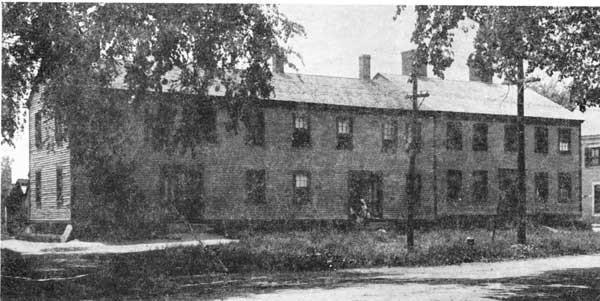
The old Middlesex Tavern in North Billerica. A rare photograph taken about 1900, showing the tavern
with the extension on the left containing Middlesex Hall (the social center for North Billerica) on the
second floor, and under it what used to be a shelter for the canal horses. The extension burned down
many years ago, but the tavern building still stands at the corner of Elm and Wilson Streets in North Billerica.
This photograph is another gift of our benefactor, Mr. Charles T. Sheldon of Milwaukee,
to whom the Association is grateful for this and many other much-appreciated gifts
The remaining section was originally the Middlesex Tavern, built by Nathan Mears on land purchased from the Middlesex canal Proprietors in 1812 and 1815. After his death it was owned by Joel Dix and then Daniel Wilson who added the ell. This ell was called Middlesex Hall and was a meeting place for residents of North Billerica, holding social events including the 1862 wedding reception for Edward Talbot, son of C. P. Talbot, owner of the Talbot Mill.
Eventually it became “tenements.” Tragically on February 6, 1934 the Lowell Fire Department was dispatched to the building when a fire was discovered. Five families; Lemay, Weckstrom, Heeney, Hughes, and Murray were able to escape. Threatened but saved was the Talbot Mill and a nearby gas station. By February 7th, the Lowell Sun was able to report that the building, owned by the Talbot Mill, sustained damages of $20,000 and was insured to cover the loss. A Whist party was held at the North Billerica Union Hall to raise money for the displaced families.
This remaining two-family home once was the scene of much activity and part of the hub of North Billerica. Hopefully, once the Museum is open, this once again will be alive with people and events.
MISCELLANY
Back Issues - More than 50 years of back issues of Towpath Topics, together with an index to the content of all issues, are also available from our website http://middlesexcanal.org/towpath. These are an excellent resource for anyone who wishes to learn more about the canal and should be particularly useful for historic researchers.
Estate Planning - To those of you who are making your final arrangements, please remember the Middlesex Canal Association. Your help is vital to our future. Thank you for considering us.
Membership and Dues – There are two categories of membership: Proprietor (voting) and Member (non-voting). Annual dues for “Proprietor” are $25 and for “Member” just $15. Additional contributions are always welcome and gratefully accepted. If interested in becoming a “Proprietor” or a “Member” of the MCA, please mail membership checks to Neil Devins, 28 Burlington Avenue, Wilmington, MA 01887.
Museum & Reardon Room Rental - The facility is available at very reasonable rates for private affairs, and for non-profit organizations to hold meetings. The conference room holds up to 60 people and includes access to a kitchen and restrooms. For details and additional information please contact the museum at 978-670-2740.
Museum Shop - Looking for that perfect gift for a Middlesex Canal aficionado? Don’t forget to check out the inventory of canal related books, maps, and other items of general interest available at the museum shop. The store is open weekends from noon to 4:00pm except during holidays.
Web Site – The URL for the Middlesex Canal Association’s web site is www.middlesexcanal.org. Our webmaster, Robert Winters, keeps the site up to date. Events, articles and other information will sometimes appear there before it can get to you through Towpath Topics. Please check the site from time to time for new entries.
The Canal the Bisected Boston: https://www.youtube.com/watch?v=u3yvlBAPGmg
The Middlesex Canal (1793-1860), dug by hand from the Merrimack River at Middlesex Village in Chelmsford to the Charles River at Charlestown during the second term of George Washington’s presidency, played a major role in the development of Boston. Boats were drawn by horse to the Charles River. There they were pulled by chain across the Charles River and down Mill Creek, which bisected the city, to the long wharfs of Boston Harbor. Written and narrated by David Dettinger, author of the definitive study of the Canal extension in Boston from 1810-1830. – Videotaped and edited by Roger Hagopian
The first issue of the Middlesex Canal Association newsletter was published in October, 1963.
Originally named “Canal News”, the first issue featured a contest to name the newsletter. A year later, the newsletter was renamed “Towpath Topics.”
Towpath Topics is edited and published by Debra Fox, Alec Ingraham, and Robert Winters.
Corrections, contributions and ideas for future issues are always welcome.